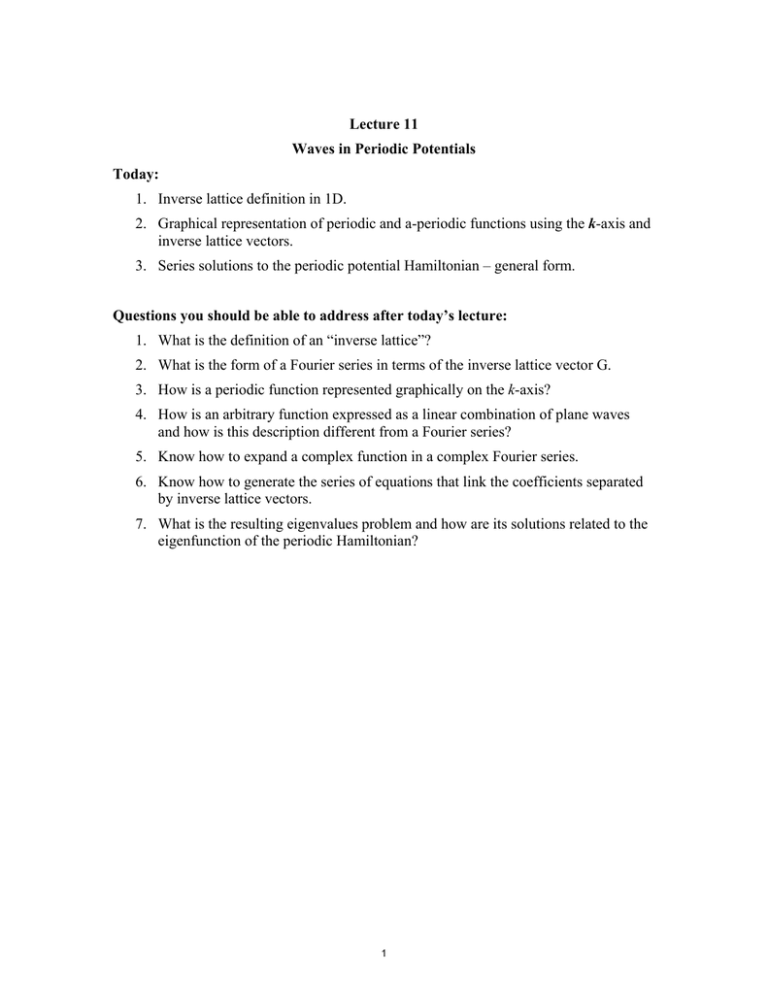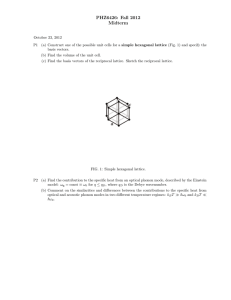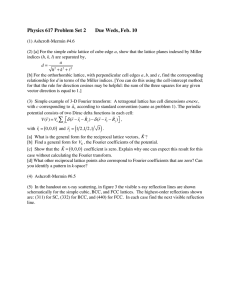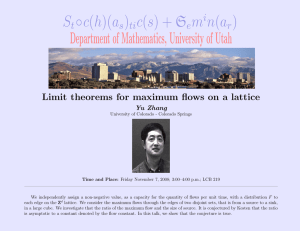Lecture 11 Waves in Periodic Potentials Today:
advertisement

Lecture 11
Waves in Periodic Potentials
Today:
1. Inverse lattice definition in 1D.
2. Graphical representation of periodic and a-periodic functions using the k-axis and
inverse lattice vectors.
3. Series solutions to the periodic potential Hamiltonian – general form.
Questions you should be able to address after today’s lecture:
1. What is the definition of an “inverse lattice”?
2. What is the form of a Fourier series in terms of the inverse lattice vector G.
3. How is a periodic function represented graphically on the k-axis?
4. How is an arbitrary function expressed as a linear combination of plane waves
and how is this description different from a Fourier series?
5. Know how to expand a complex function in a complex Fourier series.
6. Know how to generate the series of equations that link the coefficients separated
by inverse lattice vectors.
7. What is the resulting eigenvalues problem and how are its solutions related to the
eigenfunction of the periodic Hamiltonian?
1
Direct and “Reciprocal lattice” in 1D and 3D
A 1D Bravais lattice is defined by the collection of vectors that have the form: R na
a is called a primitive vector and the set of {R} form the Bravais lattice.
Clearly any point on the x-axis can be written as: x ' x na , x 0, a
Suppose we found a set of vectors G that satisfy the following relation: e iGR 1
e iGna 1 G m
2
a
(m ....1,0,1,2...) : This set of G’s also comprise a Bravais
lattice.
The reciprocal vectors form a lattice with reciprocal length dimensions (large separations
between lattice points in direct lattice leads to small separation in reciprocal lattice and
vice versa.)
Any point k in the reciprocal space (not necessarily a lattice point) can be expressed as:
2
k G, where (1D): k
a
a
a
k k m
This range is called the first Brilllouin Zone (BZ), it is the Wigner-Seitz cell of the
reciprocal lattice.
A similar approach is used to define a 2D and 3D lattice: R n1a1 n2 a2 n3a3
Suppose we found a set of vectors G that satisfy the following relation: e iGR 1
These G’s are called the reciprocal lattice vectors, and can be found in the following way:
G m1b1 m2b2 m3b3
Here a’s are the set of primitive vectors for the direct lattice and the b’s are the primitive
vectors for the reciprocal lattice given by:
a2 a3
a3 a1
a1 a2
b1 2 , b2 2 , b3 2
a1 a2 a3
a1 a2 a3
a1 a2 a3
Example simple cubic lattice: a1 ax̂, a2 aŷ, a3 aẑ
2
2
2
b1
x̂, b2
ŷ, b3
ẑ
a
a
a
Properties of Crystal momentum k.
Clearly k is a number (or vector) related to the eigenvalues of the discrete translational
operator and has units of inverse length. We mentioned above that any vector of inverse
length units can be written as a sum of a reciprocal lattice vector and a vector restricted to
the first BZ.
2
2
k k m , where the first Brillouin zone defined by: k
a
a
a
G
Going back to the eigenfunctions of the discrete translational operator.
Suppose we kept our k in the range specified above (BZ) and added to it a reciprocal
ikx iGx
lattice vector G: ukG x e e f x
This eigenfunction still corresponds to an eigenvalue of eika since by construction
eiGa 1 and thus adding G to k may modify the functional form of the periodic term but
will not obviously change the fact that it is periodic in a as eiGx is itself a periodic
function in a (therefore it can be taken to be part of f x ).
In other words in terms of labeling the states it is sufficient to consider only k’s that
are restricted to the first BZ as only they correspond to distinct eigenvalues of the
discrete translational operator.
3
Numerical solution of the periodic potential: The eigenvalue problem
We are considering a periodic potential: V x na V x
Since the function is periodic with period “a” it can be expanded in a Fourier series
where G’s are the set of reciprocal lattice vectors, i.e. a periodic function can be
expanded in terms of sine a cosine functions such that:
V0
2 n
2 n
V x An cos
x Bn sin
x
a
a
2 n1
Gn
An
2
2 n
V x cos
xdx
a 0
a
Bn
2a
2 n
V x sin
xdx
a 0
a
a
Gn
The reciprocal lattice as the collection of points G defined by the relation: e iGR 1
G
2
n gn
a
Then we can rewrite the Fourier series as:
V x
A0 cos
VG cosGx VGsin sinGx
2 Gg
VGcos
2a
V x cosGxdx
a 0
VGsin
2a
V x sinGxdx
a 0
The coefficients of the series can be represented graphically on the k axis.
V3g
V g
Vg
g
V2g
k
g
0
2g
3g
Since our functions are complex valued we will use the complex Fourier series:
V x VG e iGx
G
4
Now the Hamiltonian for the periodic potential has the following form:
2 d 2
iGx
V
e
G x Eu x
2
2m dx
G
The eigenfunctions can be written as a series. Since there is no reason to assume that the
eigenfunctions are periodic in lattice period we expand them in k: x Ck e ikx
k
Ck1
Ck2
k1
k2
k
Any particular solution φ(x) is completely defined by specifying the set of coefficients
Ck . All k’s are allowed so the k separation between two terms can be infinitesimal.
Substituting φ(x) into the periodic potential Hamiltonian:
2 d 2
iGx
Ck e ikx E Ck e ikx
V
e
G
2
2m dx
k
G
k
i Gk x
2
Ck k 2e ikx VGCk e E Ck e ikx
2m k
G k
k
Since the sum over k is infinite and k is just a running index we can change our variable
in the second sum from k k G :
2
C k 2eikx VGCkG eikx E Ck eikx
2m k k
G k
k
2
2m k 2Ck VGCkG eikx ECk eikx
G
k
k
2
2
E
V
C
k
C
2m
G kG eikx 0
k
k
G
In order for this sum to be equal to zero every component has to be zero:
2 2
2 2
k Ck VGCkG ECk
k ECk VGCkG 0
2m
2m
G
G
Unlike the situation we started with where the separation between two terms in the
expansion could be infinitesimal this equation relates all the coefficients Ck that are
5
separated by an inverse lattice vector to each other forming a set of coupled algebraic
equations (which in essence is a recursion formula).
Now all you need to do is to solve this
infinite system of equations – i.e. find the energy
eigenvalues E and the eigenvectors C composed of components Ck, which define our
trial wavefunctions: x Ck e ikx
k
6
MIT OpenCourseWare
http://ocw.mit.edu
3.024 Electronic, Optical and Magnetic Properties of Materials
Spring 2013
For information about citing these materials or our Terms of Use, visit: http://ocw.mit.edu/terms.






